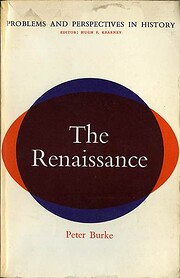

Click on a thumbnail to go to Google Books.
|
Loading... The Renaissance (Problems and Perspectives in History) (edition 1966)by Peter Burke, Hugh F. Kearney (Editor)
Work InformationThe Renaissance by Peter Burke
 Renacimiento (21) No current Talk conversations about this book.   ) )In un’Europa segnata dall’onnipotenza politica di monarchie e signorie, dall’affermazione della classe mercantile e dal progressivo riequilibrio del rapporto tra città e campagna, si fa strada la riscoperta della centralità dell’uomo: è il Rinascimento, l’inizio di un’epoca di rigenerazione e di nuova coscienza di sé. Il volume propone un’ampia sintesi su quello che allo stesso tempo fu un’idea, un movimento e un periodo storico, cominciando dalle stesse coordinate spazio-temporali: dove e quando è nato il Rinascimento? I luoghi della cultura e la centralità dell’Italia; università, cancellerie e corti; centri e periferie; lo scenario europeo.La grande fioritura della vita artistica, letteraria e culturale. Il tardo Rinascimento: l’architettura; pittura e scultura; la musica; l’ascesa delle lingue volgari. L’amore e l’odio per l’Italia: atteggiamenti e valori. Il Rinascimento dopo il Rinascimento: sopravvivenza, resistenza e riscoperta nelle culture europee. Che sia durata trenta o trecento anni, si tratta di una stagione che ha cambiato in maniera forse definitiva la nostra percezione della realtà e si è ormai accreditata ai nostri occhi come una lunga e appassionante analisi sull’uomo attraverso lo specchio della natura, della morale e della società. no reviews | add a review
Belongs to Publisher Series
In this study Peter Burke distances himself from the traditional interpretation of the Renaissance as essentially Italian, self-consciously modern and easily separable from the Middle Ages. He emphasises the survival of medieval traditions and the process of the creative adaptation of classical forms and values to their new cultural and social contexts in Italy and elsewhere in Europe. The story is carried down to the seventeenth century and the diffusion and disintegration of what had once been a coherent movement. Illustrated with black and white plates, this edition has been updated throughout to take account of recent scholarship, has a fully revised bibliography and will provide the student with a stimulating introduction to the subject. No library descriptions found. |
Current DiscussionsNonePopular covers
 Google Books — Loading... Google Books — Loading...GenresMelvil Decimal System (DDC)940.21History and Geography Europe Europe Early Modern 1453-1914 Renaissance period 1453-1517LC ClassificationRatingAverage: (4) (4)
Is this you?Become a LibraryThing Author. |
||||||||||||||||||||||||||||||||||||||||||||||||||||||||||||||||||||||||||||||||||||||||||||||||||||||||||||||||||||||||||||||||||||||||